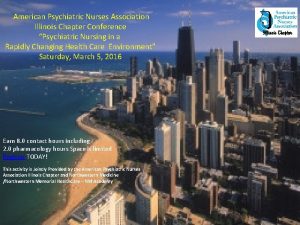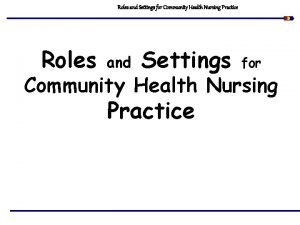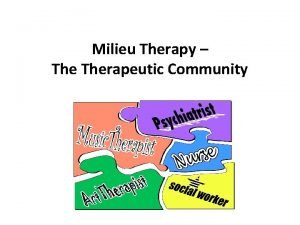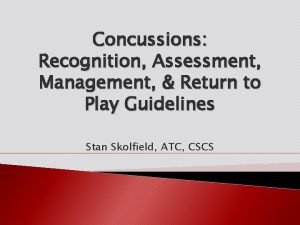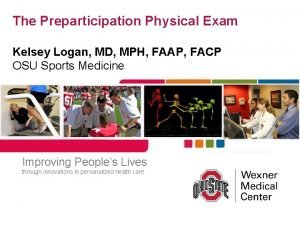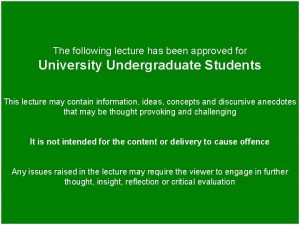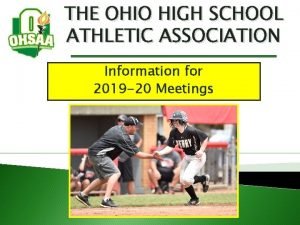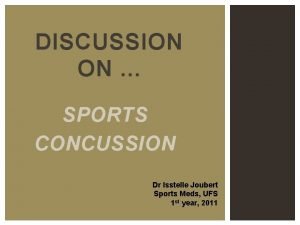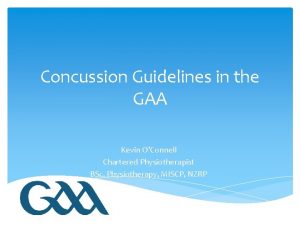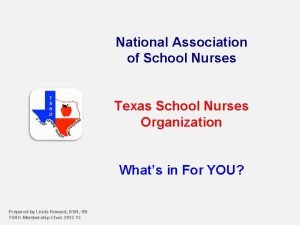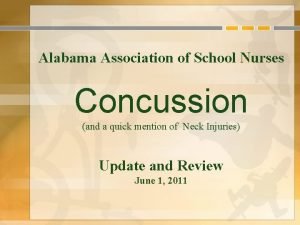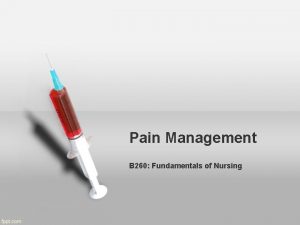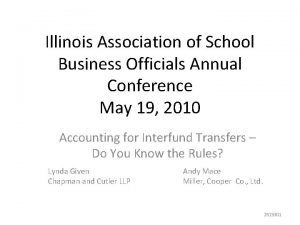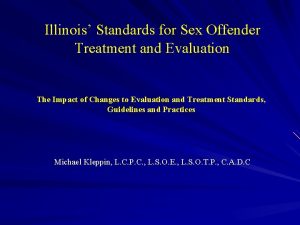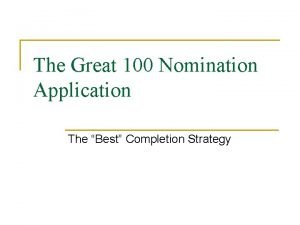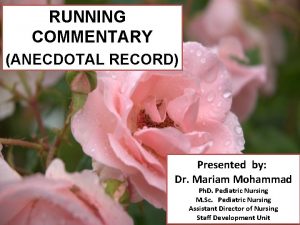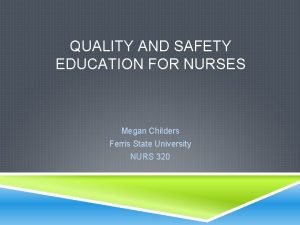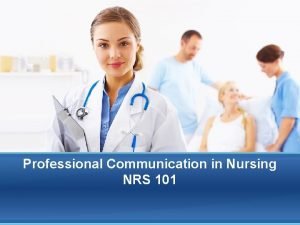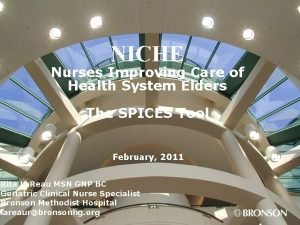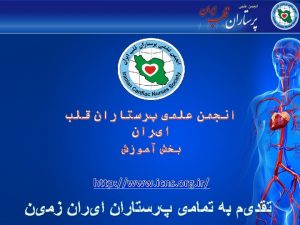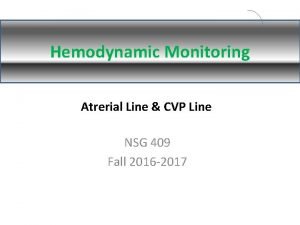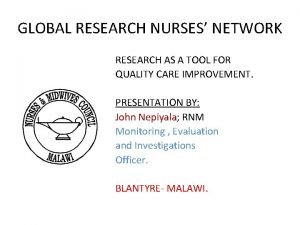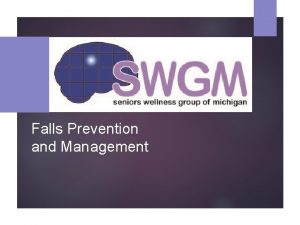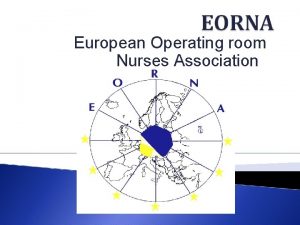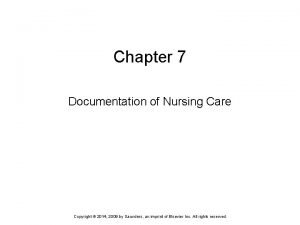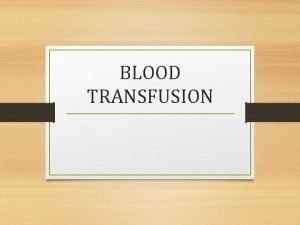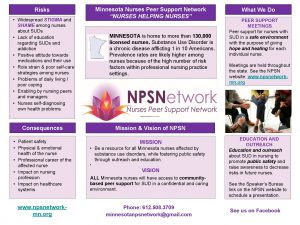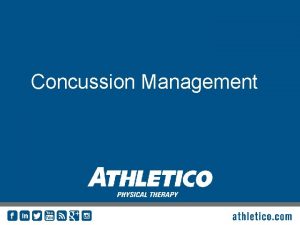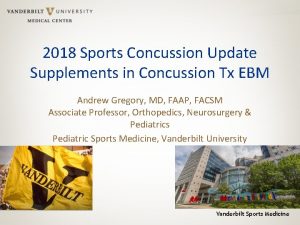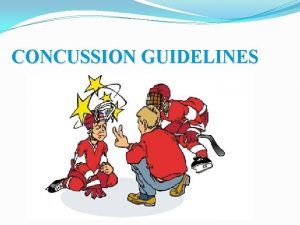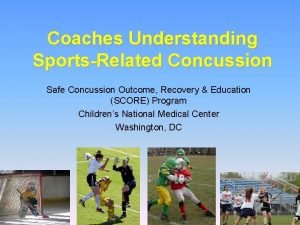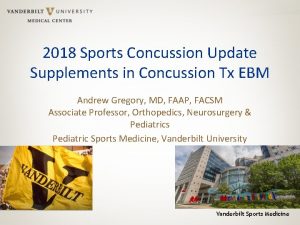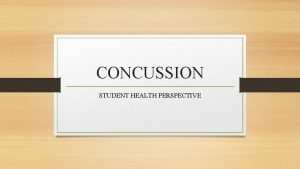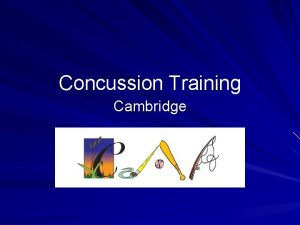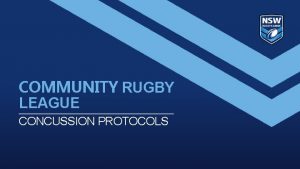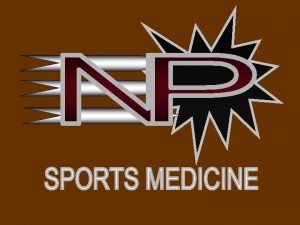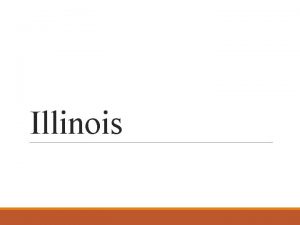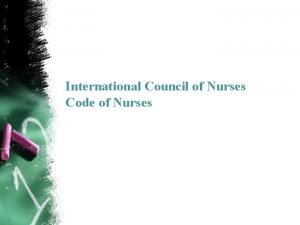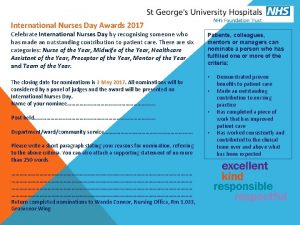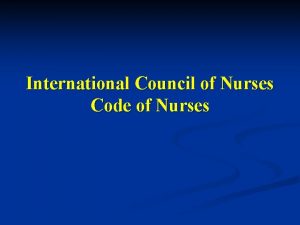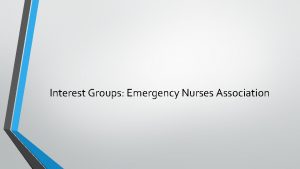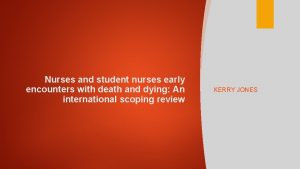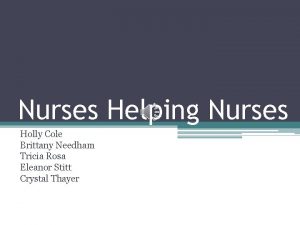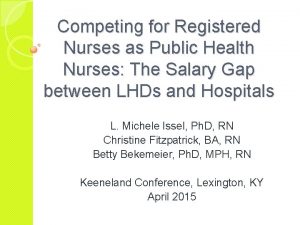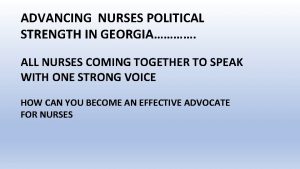The Illinois School Nurses Role in Concussion Management














































































- Slides: 78

The Illinois School Nurse’s Role in Concussion Management Presented by The Illinois Association of School Nurses

Course Description: This program is an overview of concussion education and care, designed to meet the mandated training requirement for Illinois nurses working in schools, as described in P. A. 099 -0245, The Youth Sports Concussion Safety Act. Course Objectives: Upon completion of this program, the nurse will be equipped with leadership skills and knowledge to develop and implement a comprehensive concussion protocol for a school and/or district. Target Audience: Illinois nurses working in schools. Professional Practice Gaps: ● Lack of knowledge of current evidence-based practice and laws regarding concussion care and management in schools. ● Inconsistent approaches to care and management in schools ● Inconsistent inclusion of school nurse in district/school initiatives and policies

Disclosure statement: This program was developed with financial assistance from the School Health Section of the Illinois Department of Public Health. Disclosed is the absence of personal financial relationships with commercial interests relevant to the development of this educational activity. Illinois Association of School Nurses (IASN) Ad Hoc Concussion Program Development Committee Donna Kunz RN, MS, BS, PEL-IL, NCSN Donna received her Diploma in Nursing at Ravenswood Hospital, Chicago, IL in 1974, a BS in Psychology at Roosevelt University, Chicago, IL in 2000, and an MS in Public Health Nursing with a specialization in School Nursing in 2009. Donna was a hospital staff nurse in Pediatrics, Obstetrics/Gynecology, and Psychiatry for 25 years, and has been a high school nurse for 22 years. Currently employed at Huntley High School in Huntley, IL, Donna has been active in IASN for 10 years, as representative to various Illinois health organizations, and is currently the IASN representative to the Illinois Education Association. She is a member of her school’s concussion oversight team. Cameron Traut RN, MS, BSN, PEL-IL, NCSN Cameron received her BSN from Valparaiso University in 1986, and an MS with a specialization in Counseling Studies in 2008. She was a staff nurse in the PICU at Children’s Memorial Hospital, Chicago, IL, for 9 years, and has been a school nurse for 20 years. Currently employed at Libertyville High School, in Libertyville, IL, Cameron has been active in IASN for 20 years, holding offices such as past IASN president, and currently as IASN representative to ANA-IL and the Illinois Director to the NASN board. She led development of concussion protocol at her school and has presented on this topic to school nurses in Illinois. Linda Vollinger RN, MS, BSN, PEL-IL Linda received her BSN from University of Illinois at Chicago (UIC), Chicago, IL in 1988, and an MS in Public Health Nursing with a specialization in school nursing in 2008 from UIC, Chicago, IL. She was an ER nurse in the Chicago area for 14 years, and has been a school nurse for 14 years, in an elementary school setting, and currently at A. A. Stagg High School in Palos Hills, IL. Linda has been a member of IASN for 14 years, serving in various leadership roles, currently as president of IASN. She is a member of her school’s concussion oversight team.

Pre-Test True or False 1. The most common signs and symptoms of a concussion include: headache, dizziness, nausea, vomiting, and loss of consciousness.

Correct answer: FALSE

True or False 2. Approximately 80 -90% of student athletes find that the symptoms of a concussion will resolve in 2 -3 weeks.

Correct answer: TRUE

True or False 3. The school nurse plays an important role on the school’s oversight team.

Correct answer: TRUE

True or False 4. A concussion will affect a student physically, cognitively, emotionally and may even affect sleep.

Correct answer: TRUE

True or False 5. A concussion can be diagnosed with a skull x-ray, CAT scan and/or a MRI.

Correct answer: FALSE

True or False 6. Some factors that may impede recovery from a concussion include: a history of prior concussions, a history of headaches or migraines, a diagnosis of ADHD, learning disability, or sleep disorder, but NOT mental health disorders.

Correct answer: FALSE

True or False 7. Currently, cognitive rest is the initial treatment of choice for concussion.

Correct answer: TRUE

True or False 8. In Illinois, students must have a physician’s clearance to begin the Return-to-Learn and the Return-to-Play Protocols.

Correct answer: TRUE

True or False 9. Some examples of cognitive stimulation may include: driving, playing video games, screen time (cell phone, computer, smart boards, TV), loud or bright environments, reading or studying.

Correct answer: TRUE

True or False 10. Second impact syndrome can cause brain swelling and bleeding. It is rarely fatal.

Correct answer: FALSE

Current Illinois Laws PA 097 -0204 Protecting our Student Athletes Act (2011) PA 098 -1011 Amendment to The Interscholastic Athletic Organization Act (2014) PA 099 -0245 Youth Sports Concussion Safety Act (2015) PA 099 -0831 Amendment to The Interscholastic Athletic Organization Act (2016) (Illinois General Assembly, 2016)

Definition of a Concussion The 5 th International Conference on Concussion in Sport (Berlin, 2016) - defines a concussion as a traumatic injury, induced by biomechanical forces. - may be caused by a direct blow to the head, face, neck, or elsewhere on the body with an “impulsive” force transmitted to the head. - typically results in the rapid onset of short-lived impairment of neurological function that resolves spontaneously. In some cases, signs/symptoms evolve over minutes to hours. - signs/symptoms typically reflect a functional not structural injury - a range of sign/symptoms: may or may not include LOC, cannot be explained by substance use, other injuries, or comorbidities, with resolution being a sequential path, sometimes prolonged. The Centers for Disease Control (CDC): A concussion is a type of traumatic brain injury—or TBI—caused by a bump, blow, or jolt to the head or by a hit to the body that causes the head and brain to move rapidly back and forth. This sudden movement can cause the brain to bounce around or twist in the skull, stretching and damaging the brain cells and creating chemical changes in the brain.

Pathophysiology of a Concussion Giza & Hovda, 2014

Prevalence of Concussions Most current study on incidence - July 2016 (Seattle Sports Concussion Research Collaborative): Annually, more than 44 million youth participate in sports. Estimated incidence is between 1. 1 - 1. 9 million children </= 18 years annually. IOM Committee Report (2014): Football is highest in reported incidence of all sports (men’s and women’s). Men’s sports: football, ice hockey, lacrosse, wrestling, soccer Women’s sports: soccer, lacrosse, basketball, ice hockey Other non-sport mechanisms of injury: skate boards/long boards, skiing, MVAs, altercations, falls ……

Common Presentation of Symptoms ● Symptoms can be immediate or gradually evolve over hours/days (Mc. Crory, et al. 2012) ● Somatic: headache or “pressure”, dizziness, nausea, neck pain, visual changes, auditory sensitivities, fatigue, interrupted sleep, inability to sleep, balance problems, “does not feel right” (CDC, 2016 a) ● Visual symptoms: difficulty tracking, convergence and focusing issues, light sensitivity, blurred or double vision, appearance of words moving on page (Master, et al. 2015) ● Cognitive: slower processing, poor executive functioning, easily distracted/unable to focus, feeling foggy/in a daze, memory issues, feeling slowed down or sluggish (Baker, et al. 2015) ● Emotional/behavioral: lability, mood swings, nervous/anxious, irritability, sadness (CDC, 2016 a) ● Symptoms reported by parents and/or school staff: appears dazed or confused, answers questions or performs tasks more slowly, repeats questions or statements, can’t recall events prior to or after injury, changes in behavior or personality, seems very forgetful of common/repetitive things like class schedule/routines (CDC, 2016 a) ● Other noticeable complaints or challenges: lack of attendance, unable to tolerate or attend band, choir, sports practices or competitions, loud or high activity areas (PE class, cafeteria, halls), difficulty looking up at classroom screen/board then at desk/paper/taking notes, inability to tolerate “screen time, ” math/science computations difficult

Duration of symptoms Typical recovery period for children and adolescents is longer than adults - about 2 weeks. (Mc. Avoy, 2012) and can last up to 4 weeks (Mc. Crory, Meeuwisse, Dvorak, et al. 2017). About 50% of adolescents recover within 1 -3 weeks. ~40% recover in 3 -6 weeks. ~6% recover in 2 -3 months. ~4% recover after 3 months. Symptoms of each aspect (somatic, cognitive, emotional/behavioral) affected by the concussion may recover at different rates. (Sady, et al. 2011) Premorbid conditions may affect the duration of recovery of all or some symptoms such as mental health conditions, prior history of concussion, and headache/migraines. (Mc. Crory, Meeuwisse, Dvorak, et al. 2017)

Assessment Tools & Baseline Testing (Resch & Kutcher, 2015) ● Annual physical exam ● Computerized neurocognitive testing ○ Im. PACT, King-Devick, CNS Vital Signs, Axon Sports, ANAM ● Sideline testing ○ SCAT (Sideline Concussion Assessment Tool) ○ BESS (Balance Error Scoring System) ○ SAC (Standardized Assessment of Concussion) ● Traditional imaging ○ X-ray, MRI, CT ● Emerging tests ● Graded symptom scales (Piebes et al. , 2009)

Current Treatment of Concussions (Mc. Crory, Meeuwisse, Dvorak, et al. 2017) • After diagnosis, the initial step is to begin a short period of full cognitive and physical rest (approx 24 -48 hrs. ) • Re-introduce normal activities of daily living, at a sub-symptom threshold, while avoiding vigorous physical exertion (i. e. sports) • Light aerobic activity may be tolerable and therapeutic. • Incorporate brief periods of rest during recovery as needed or when symptoms worsen. • Goal: to keep daily cognitive and physical symptoms during any activity at sub-symptom threshold level.

Return to Learn (RTL) • RTL is the gradual reintroduction of cognitive learning. • Differs for each student with every concussion • Subjective in nature • Evidence suggests that using a concussed brain too much to learn may worsen the concussion symptoms and may prolong recovery. • Achieving the proper balance of cognitive rest and a gradual RTL can be challenging. Maintaining a sub-symptom threshold is important.

RTL continued …. . . • When to begin • Cognitive activities are introduced slowly, keeping symptoms at a subthreshold level. • If an activity triggers symptoms, the activity should be stopped and the student should rest. • Repeat activity, as tolerated, several times a day; over the course of several days until the student is able to tolerate full activities. • Collaborate with parent and primary care physician to compare symptoms observed and reported in different settings.

RTL continued …. . . • Attending school can cause an increase in symptoms and fatigue • Homework at home before attempting school work at school. • A return to a partial school day or a few class periods is recommended when the student is able to tolerate a small amount of homework at home. • Goal: gradually advance attendance as tolerated to full-time attendance with minimal to no symptoms.

RTL continued …. . . • Full day attendance - some accommodations are still needed - no more than 1 test or assessment/day, portioned, untimed - Extended time for in class work and due dates - Reduction or elimination of non-essential assignments • RTL can be anxiety-provoking. • Faculty and administration – education • RTL begins before Return To Play, but both can occur at the same time. (multiple resources in References and Resources)

Graduated Return to School Strategy from 2016 (5 th) Consensus Statement on Concussion in Sport ( Mc. Crory, Meeuwisse, Dvorak, et al. 2017) Stage Aim Activity Goal of Each Step 1 Daily activities at home Typical activities of the child during the day as that do not give the child long as they do not increase symptoms (eg, symptoms reading, texting, screen time). Start with 5– 15 min at a time and gradually build up Gradual return to typical activities 2 School activities Homework, reading or other cognitive activities outside of the classroom Increase tolerance to cognitive work 3 Return to school parttime Gradual introduction of schoolwork. May need to start with a partial school day or with increased breaks during the day Increase academic activities 4 Return to school full time Gradually progress school activities until a full day can be tolerated Return to full academic activities and catch up on missed work

Commonly Recommended Classroom Accommodations • Eliminate non-essential assignments or reduce assignments to the least amount possible to demonstrate mastery of the concept • Testing: no more than 1 test per day, untimed, portion out test over multiple days if needed • Avoid scantron type testing - allow student to write on paper copy of test • Preferential seating to reduce distractions • Allow rest breaks as needed, especially with reading and screen time • Consider the time of day when a subject is taught due to fatigue • Provide extra time for assignments/homework/testing to allow for slower reading/processing • Do not penalize for unfinished work • Provide printed notes, class outlines, tests/assessments on softly colored paper with enlarged font • Allow dictation for writing assignments • Develop a cueing system if student is experiencing difficulty with attention • Break down large projects and instructions into smaller portions (multiple resources in References and Resources)

More Classroom Accommodation Ideas…. . . • Provide study guides • Provide a copy of class notes/powerpoint presentation/skeletal notes • Allow student to turn in hand-written assignments rather than computer-based. • Provide tutoring • Provide a second set of books when possible. • Allow student to utilize audio versions of texts when possible and text to speech apps • Sunglasses or baseball cap in classroom to decrease light sensitivity • Ear plugs for fire drills • No Driver’s Ed - Behind the Wheel or Fine Arts participation (choir, band, rehearsals, musical, plays, etc. ) until cleared by physician • Leave classes early to avoid congested and noisy hallways • Lunch in a different location to avoid congested noisy cafeteria (multiple resources in References and Resources)

Return to Play (RTP) • More familiar to health care providers, families and school staff than RTL • Gradual increase in physical activity in a step-by-step progression; it is important that the activity does not trigger or worsen the concussion symptoms. • Begins once the student has achieved returning to a full day of school without symptoms while tolerating a full academic workload without accommodations. • Subjective reporting • Different from new recommendation of light physical activity during recovery.

Return to Play (RTP) Step 1: Light aerobic activity The Goal: Only to increase an athlete’s heart rate. The Time: 5 to 10 minutes. The Activities: Exercise bike, walking, or light jogging. Absolutely no weight lifting, jumping or hard running. Step 2: Moderate activity The Goal: Limited body and head movement. The Time: Reduced from typical routine. The Activities: Moderate jogging, brief running, moderate-intensity stationary biking, and moderate-intensity weightlifting Step 3: Heavy, non-contact activity The Goal: More intense but non-contact The Time: Close to typical routine The Activities: Running, high-intensity stationary biking, the player’s regular weightlifting routine, and non-contact sport-specific drills. This stage may add some cognitive component to practice in addition to the aerobic and movement components introduced in Steps 1 and 2. Step 4: Practice & full contact The Goal: Reintegrate in full contact practice. Step 5: Competition The Goal: Return to competition.

Post Concussion Syndrome Some students experience post-concussive symptoms that persist from 6 weeks to 6 months. Post Concussion Syndrome is defined as symptoms lasting 3 months or longer (CDC, 2016). Symptoms may include: headache in almost all cases as well as: Dizziness (60% of cases) Hearing loss (20% of cases) Sleep disorders Loss of taste or smell Memory issues Attention issues Student should be referred to a concussion specialist. Accommodations at school will have become more complex: Adjusting school day (shortening it by removing a class, medically exempting from PE and other classes as needed) Tutoring (homebound tutoring support) Changing course levels (honors to “regular”) 504 plan (Lurie Children’s Hospital, Institute of Sports Medicine, 2015) Accommodations may become modifications requiring the support of an IEP.

Second Impact Syndrome (SIS) • Definition: An individual who sustained a head injury receives a second head injury before the brain has recovered from the first injury. • Cause does not have to be a direct blow to the head, but may be caused by a hit to the side, chest, or back that jerks the head. • A severe form of reinjury that results in the loss of the brain’s ability to auto-regulate blood flow resulting in rapid swelling of the brain. • Differs from other concussions by the symptomatology presented on the field. • Symptoms progress quickly. • Can have catastrophic or fatal results. • Prevalence is rare. • Noted primarily in high school athletes. (Cobb & Battin, 2004)

School Nurse’s Role: Concussion Oversight Team Leader Concussion Oversight Team: School Nurse School Psychologist School Counselor Athletic Director Physician PE Teachers Coach Administrator School Social Worker Parent Athletic Trainer Special Education Representative

Developing a Concussion Protocol - Things to Consider ● Identify the issue/collect data = show the need ● Learn more about the issue - evidence based research, laws ● Contact school nursing colleagues and resources, local experts ● Policy vs. Protocol - know the difference Protocol: An agreed framework outlining the care that will be provided to patients in a designated area of practice. They do not describe how a procedure is performed, but why, where, when and by whom the care is given. (University of Wisconsin-Madison, Health Sciences, 2016) Policy: A formal written statement detailing the particular action to be taken in a particular situation that is contractually binding. (University of Wisconsin-Madison, Health Sciences, 2016) ● Identify stakeholders ● Create a plan (rough draft, timeline) ● Present information and plan to stakeholders

School Nurse’s Role: Coordinator of Care Multidisciplinary Team Members: athletic trainer, teachers, coach, parents, student, primary care physician, social worker, school counselor If symptoms are prolonged, add: concussion specialist (neurologist, neuropsychiatrist) school psychologist special education staff other specialists (vision, OT, PT, counselor)

School Nurse’s Role: Prevention Elementary schools: recess equipment, PE classes, education for parents, students, teachers, coaches High Schools: PE classes, sports (additional staff), education for teachers, parents, students, coaches Access to Emergency & Primary Care Presence of an Athletic Trainer Culture Change of reporting concussions (student, parent, coaches) (Glassman & Holt, 2011)

School Nurse’s Role : Evaluator (NASN, 2016) • Always be open to feedback from team members • Review process within each student’s experience • Reconvene concussion oversight committee regularly (at least annually) • Review protocol for updates and changes

School Nurse’s Role: Innovator and Resource (NASN, 2016 b) • Daily concussion assessment • Communication examples to staff • Resource in a school for concussion care and management: local hospital systems (specialists), CDC, IHSA, other state/national programs, medical links

Legal Considerations & Issues (Traut & Dube, 2016) Concussion management in a school setting is a complex issue. Duty of Safe Care (Schoepfer-Bochicchio & Dodds, 2015) Examples of issues that may arise…. . ● PE/recess participation without formal RTP in place in these areas. ○ Does the nurse manage RTP? Give recommendations to PE teacher? Have student report to nurse after PE every day? Send student to AT? ○ How is return to recess handled? ● Club or private sports organizations outside of school. ○ Student begins RTP with club sport while not cleared by physician for school RTL. ● Physician recommendations are not in alignment with current best practices for concussion management or school protocol.

Decision-Making Checklist 1. Federal Laws 2. State Nurse Practice Act 3. State Board of Health 4. State Board of Education 5. Local school District Policy 6. Current nursing standards for best practice a. School nursing scope and standards of practice b. ANA scope and standards of nursing practice 7. Current evidence-based research 8. Professional organizations (NASN, state school nurse organizations, ASHA…) 9. Examples of litigation/liability cases (Traut & Dube, 2016)

Post-Test True or False 1. The most common signs and symptoms of a concussion include: headache, dizziness, nausea, vomiting, and loss of consciousness.

Correct answer: FALSE Loss of consciousness occurs in only 10 -20% of concussion injuries. (Resch & Kutcher, 2015)

True or False 2. Approximately 80 -90% of student athletes find that the symptoms of a concussion will resolve in 2 -3 weeks.

Correct answer: TRUE

True or False 3. The school nurse plays an important role on the school’s oversight team.

Correct answer: TRUE The school nurse is the care coordinator and leader of the individual student’s team as well as a leader/member of the school or district’s concussion oversight team. (NASN, 2016 b)

True or False 4. A concussion will affect a student physically, cognitively, emotionally and may even affect sleep.

Correct answer: TRUE Symptoms of a concussion are grouped into 4 main areas: physical, emotional/behavioral, cognitive, and sleep. (Mc. Crory et al. , 2013)

True or False 5. A concussion can be diagnosed with a skull x-ray, CAT scan and/or a MRI.

Correct answer: FALSE Traditional imaging such as x-rays, MRI’s (magnetic resonance imaging) and CT scans (computerized tomography) are not diagnostic tools because of the functional nature of a concussion injury, but they will assist with ruling out structural traumatic injuries such as skull fractures or bleeding. (IOM & NRC, 2014)

True or False 6. Some factors that may impede recovery from a concussion include: a history of prior concussions, a history of headaches or migraines, a diagnosis of ADHD, learning disability, or sleep disorder, but NOT mental health disorders.

Correct answer: FALSE Mental health disorders may affect concussion recovery in terms of symptom presentation and prolonged recovery time. (Sady et al. , 2011)

True or False 7. Currently, cognitive rest is the initial treatment of choice for concussion.

Correct answer: TRUE Complete cognitive rest is part of the initial treatment plan while symptoms are more acutely intense, approximately 2448 hours. As the student recovers, periods of cognitive rest are still a part of the treatment plan, but the amount needed lessens as symptoms resolve. (Schneider, 2016) (Remaly, 2016) (Mc. Crory et al. , 2017)

True or False 8. In Illinois, students must have a physician’s clearance to begin the Return-to-Learn and the Return-to-Play Protocols.

Correct answer: TRUE According to PA 099 -0486, The Youth Sports Concussion Safety Act, the treating physician must provide a statement indicating the student is ready to return to learn and return to play. (Illinois General Assembly, 2016)

True or False 9. Some examples of cognitive stimulation may include: driving, playing video games, screen time (cell phone, computer, smart boards, TV), loud or bright environments, reading or studying.

Correct answer: TRUE Examples of cognitive stimulation include any electronic screen such as TVs, cell phones, computers, smart boards in classrooms, video games, driving a car, reading, studying, taking a test or quiz, taking notes, particular areas of a school which are loud or bright (cafeteria, music, PE, drama, sports). (Halstead et al. , 2013)

True or False 10. Second impact syndrome can cause brain swelling and bleeding. It is rarely fatal.

Correct answer: FALSE A rare but very serious complication of a concussion is Second Impact Syndrome. The definition of Second Impact Syndrome is a subsequent concussion injury an individual sustains before the brain has recovered from the initial concussion injury. It is a severe form of reinjury that results in the loss of the brain’s ability to auto-regulate blood flow which results in rapid swelling of the brain. (Cobb & Battin, 2004)

Program Feedback Thank you for completing this education module! We hope it was beneficial to you and your career. To give us feedback, please email Linda Gibbons at iaschoolnurses@gmail. com with your thoughts. Thanks again!

References Baker, J. G. , Rieger, B. P. , Mc. Avoy, K. , Leddy, J. J. , Master, C. L. , Lana, S. J. , and Willer, B. S. (2014). Principles for return to learn after concussion. International Journal of Clinical Practice, 68(11). 1286 -1288. Bryan, M. A. , Rowhani-Rahbar, A. , Comstock, R. D. , & Rivara, F. (2016). Sports- and recreation-related concussions in US Youth. Pediatrics, 138(1), 1 -8. doi: 10. 1542/peds. 2015 -4635 Centers for Disease Control and Prevention (CDC). (2016 a). Heads up to schools. Atlanta, GA: National Center for Injury Prevention and Control; Division of Unintentional Injury Prevention. Retrieved from http: //www. cdc. gov/headsup/schools/index. html Cobb, S. & Battin, B. (2004). Second Impact Syndrome. The Journal of School Nursing, 20(5), 262 -267. Giza, C. C. & Hovda, D. H. (2014). The new neurometabolic cascade of concussion. Neurosurgery, 75(04), S 24 -S 33. Glassman, S. J. & Holt, B. J. (2011). Concussions and student-athletes: Medical-legal issues in concussion care and physician and school system risks. New Hampshire Bar Journal, 52(3), 26 -35. Retrieved from https: //www. nhbar. org/uploads/pdf/BJ-Autumn 2011 -Vol 52 -No 3 -Pg 26. pdf Halstead, M. E. , Mc. Avoy, K. , Devore, C. D. , Carl, R. , Lee, M. , Logan, K. (2013). Returning to learning following a concussion. Pediatrics, 132, 948 -957.

References Illinois General Assembly (2016). General assembly public acts. Springfield, IL. Retrieved from http: //ilga. gov/ Institute of Medicine (IOM) and National Research Council (NRC). (2014). Sports-related concussions in youth: Improving the science, changing the culture. . Washington D. C. : National Academies Press. Retrieved from http: //www. ncbi. nlm. nih. gov/books/NBK 169016/ Lurie Children’s Hospital, Institute of Sports Medicine (2015). Return to learn after a concussion: A guide for teachers and school professionals. Chicago, IL. Retrieved from: http: //luriechildrens. peachnewmedia. com/store/seminar. php? seminar=45893 Masters, C. L. , Gioia, G. A. , Leddy, J. J. , and Grady, M. F. (2012). Importance of ‘return-to-learn’ in pediatric and adolescent concussion. Pediatric Annals, 41(9). 1 -6. Mc. Avoy, K. (2015). Research-based practice return to learning: Going back to school following a concussion. Communique, 40, 6. Mc. Crory, P. , Meeuwisse, W. H. , Aubry, M. , Cantu, B. , Dvorak, J. , Echemendia, R. J. , . . . Turner, M. (2013). Consensus statement on concussion in sport: The 4 th international conference on concussion in sport held in Zurich, November 2012. British Journal of Sports Medicine, 47, 250 -258. doi: 10. 1136/bjsports-2013 -092313

References National Association of School Nurses. (2016 a). Concussions - the role of the school nurse (Position Statement). Silver Spring, MD: Author. Retrieved from: http: //www. nasn. org/Policy. Advocacy/Position. Papersand. Reports/NASNPosition. Statements. Full. View/tabid/462/Article. Id/218/ Concussions-The-Role-of-the-School-Nurse-Revised-June-2016 National Association of School Nurses. (2016 b). Framework for 21 st century school nursing practice. NASN School Nurse, 31(1), 45 -53. doi: 10. 1177/1942602 X 15618644 Nebraska Department of Education (2014). Bridging the gap from concussion to the classroom return to learn. Lincoln, NE. Retrieved from: https: //www. education. ne. gov/sped/birsst/BRIDGING%20 THE%20 GAP%20 Booklet%20 plus%20 Appendices. pdf Piebes, S. , Gourley, M. , & Valovich Mc. Leod, T. (2009). Caring for student-athletes following a concussion. The Journal of School Nursing, 25(4), 270 -218. Purcell, L. , Harvey, J. , Seabrook, J. A. (2015). Patterns of recovery following sport-related concussion in children and adolescents. Clinical Pediatrics, 1 -7.

References Rains, C. & Robinson, B. (2010). School nurses and athletic trainers team up on concussion management. National Association of School Nurses, 235 -238. Remaly, J. (2016). Looking beyond rest to active and targeted treatments for concussion. Neurology Review, 24(6), 1, 32 -33. Retrieved from http: //www. neurologyreviews. com/specialty-focus/traumatic-brain-injury-tbi/article/looking-beyond-rest-toactive-and-targeted-treatments-for-concussion/2 fdc 2 b 5 d 656 e 136 eb 42983 a 3 a 3 a 5 dd 37. html Resch, J. E. , & Kutcher, J. S. (2015). The acute management of sport concussion in pediatric athletes. Journal of Child Neurology, 30(12), 1686 -1694. Proctor, S. (2013). Standards of practice. In J. Selekman (Ed. ), School Nursing: A comprehensive text (2 nd ed. ) (48 -78). Philadelphia, PA: F. A. Davis Company. Sady, M. D. , Vaughan, C. G. , Gioia, G. A. (2011). School and the concussion youth: Recommendations for concussion education and management. Physical Medicine and Rehabilitation Clinics of North America, 22(4), 701 -719. Schneider, K. (2016). Cognitive rest: An integrated literature review. The Journal of School Nursing, 20(4), 262 -267.

References Schoepfer-Bochicchio, K. & Dodds, M. (2015). Concussion lawsuit examines school nurse’s duty of care. Retrieved from http: //www. athleticbusiness. com/civil-actions/concussion-lawsuit-examines-school-nurse-s-duty-of-care. html Shannon, R. A. & Gerdes, J. H. (2016). Developing school health policies, protocols, and procedures? Help please! [Power. Point slides]. Presentation, NASN Annual Conference, June 24, 2016. Traut, C. & Dube, N. (2016). Concussons. Manuscript submitted for publication. University of Wisconsin-Madison, Health Sciences (2016). Nursing resources: Standard, guideline, protocol, policy. Madison, WI : Ebling Library. Retrieved from http: //researchguides. ebling. library. wisc. edu/c. php? g=293229&p=1953402 Wing, R. , Amanuallah, S. , Jacobs, E. , Clark, M. A. , and Merritt, C. (2015). Heads up: Communication is key In school nurses’ preparedness for facilitating “return to learn” following concussion. Clinical Pediatrics, 55(3). 228 -235. Yonkaitis, C. F. & Shannon, R. A. (2016). Why, When, Where, What and how to write IEP goals and objectives: Skills for school nurses [Power. Point slides]. Presentation, NASN Annual Conference, July 1, 2016. Zirkel, P. A. & Eagan Brown, B. (2015). K-12 students with concussions: A legal perspective. The Journal of School Nursing, 31(2), 99 -109. doi: 10. 1177/1059840514521465

Resources American Academy of Neurology (2016). Sports concussion resources. Minneapolis, MN. Retrieved from: https: //www. aan. com/contact-aan/ Centers for Disease Control and Prevention. (2016 b). HEADS UP to brain injury. Atlanta, GA. : National Center for Injury Prevention and Control; Division of Unintentional Injury Prevention. Retrieved from: https: //www. cdc. gov/headsup/ Centers for Disease Control and Prevention. (2016 c). HEADS UP to brain injury: Acute concussion evaluation care plan. Atlanta, GA. : National Center for Injury Prevention and Control; Division of Unintentional Injury Prevention. Retrieved from: http: //www. cdc. gov/headsup/pdfs/providers/ace_care_plan_school_version_a. pdf Denehy, J. (2008). Editorial: Leadership characteristics. The Journal of School Nursing, 24(3), 107 -110. Illinois High School Association (2016). Concussion management. Bloomington, IL. Retrieved from http: //www. ihsa. org/Resources/Sports. Medicine/Concussion. Management. aspx Glenbrook South High School (n. d. ) Glenbrook South High School post-concussion return to academics and athletics [revised]. Glenview, IL. Retrieved from: https: //www. glenbrook 225. org/gbs/Athletics/Training. Program/Documents/Academic-Policy-Concussionpdf. aspx Ladd, V. J. (2009). School nurses: Positive deviant leaders in the school setting. The Journal of School Nursing, 25(1), 614.

Resources National Federation of High Schools (2015). Sports medicine. Indianapolis, IN. Retrieved from: https: //www. nfhs. org/resources/sports-medicine/ Nationwide Children’s Hospital (2016). Concussion toolkit. Columbus, OH. Retrieved from : http: //www. nationwidechildrens. org/concussion-toolkit University of Pittsburgh Medical Center (2016). Sports medicine concussion program. Pittsburgh, PA. Retrieved from: http: //www. upmc. com/Services/sports-medicine/services/concussion/Pages/default. aspx U. S. National Library of Medicine (2016). Medline plus: Concussion. Bethesda, MD: U. S. Department of Health and Human Services, National Institute of Health. Retrieved from: https: //medlineplus. gov/concussion. html
 Psychiatric nurse conference
Psychiatric nurse conference Student nurse reflection examples
Student nurse reflection examples Milieu therapy introduction
Milieu therapy introduction Grade 2 concussion
Grade 2 concussion Grade 2 concussion
Grade 2 concussion Concussion
Concussion Nausea vomitting
Nausea vomitting Ohsaa eligibility rules
Ohsaa eligibility rules Pwcs concussion training 2021
Pwcs concussion training 2021 Concussion betekenis
Concussion betekenis Concussion protocol gaa
Concussion protocol gaa Texas school safety center
Texas school safety center Alabama association of school nurses
Alabama association of school nurses Pain fundamentals of nursing
Pain fundamentals of nursing Cploa
Cploa Illinois sex offender management board
Illinois sex offender management board Worker role azure
Worker role azure Role making role taking beispiele
Role making role taking beispiele Statuses and their related roles determine the structure
Statuses and their related roles determine the structure Hình ảnh bộ gõ cơ thể búng tay
Hình ảnh bộ gõ cơ thể búng tay Lp html
Lp html Bổ thể
Bổ thể Tỉ lệ cơ thể trẻ em
Tỉ lệ cơ thể trẻ em Gấu đi như thế nào
Gấu đi như thế nào Chụp tư thế worms-breton
Chụp tư thế worms-breton Hát lên người ơi alleluia
Hát lên người ơi alleluia Các môn thể thao bắt đầu bằng tiếng đua
Các môn thể thao bắt đầu bằng tiếng đua Thế nào là hệ số cao nhất
Thế nào là hệ số cao nhất Các châu lục và đại dương trên thế giới
Các châu lục và đại dương trên thế giới Công thức tiính động năng
Công thức tiính động năng Trời xanh đây là của chúng ta thể thơ
Trời xanh đây là của chúng ta thể thơ Mật thư anh em như thể tay chân
Mật thư anh em như thể tay chân 101012 bằng
101012 bằng Phản ứng thế ankan
Phản ứng thế ankan Các châu lục và đại dương trên thế giới
Các châu lục và đại dương trên thế giới Thơ thất ngôn tứ tuyệt đường luật
Thơ thất ngôn tứ tuyệt đường luật Quá trình desamine hóa có thể tạo ra
Quá trình desamine hóa có thể tạo ra Một số thể thơ truyền thống
Một số thể thơ truyền thống Cái miệng nó xinh thế chỉ nói điều hay thôi
Cái miệng nó xinh thế chỉ nói điều hay thôi Vẽ hình chiếu vuông góc của vật thể sau
Vẽ hình chiếu vuông góc của vật thể sau Thế nào là sự mỏi cơ
Thế nào là sự mỏi cơ đặc điểm cơ thể của người tối cổ
đặc điểm cơ thể của người tối cổ Thế nào là giọng cùng tên?
Thế nào là giọng cùng tên? Vẽ hình chiếu đứng bằng cạnh của vật thể
Vẽ hình chiếu đứng bằng cạnh của vật thể Tia chieu sa te
Tia chieu sa te Thẻ vin
Thẻ vin đại từ thay thế
đại từ thay thế điện thế nghỉ
điện thế nghỉ Tư thế ngồi viết
Tư thế ngồi viết Diễn thế sinh thái là
Diễn thế sinh thái là Dot
Dot Số nguyên tố là gì
Số nguyên tố là gì Tư thế ngồi viết
Tư thế ngồi viết Lời thề hippocrates
Lời thề hippocrates Thiếu nhi thế giới liên hoan
Thiếu nhi thế giới liên hoan ưu thế lai là gì
ưu thế lai là gì Hổ đẻ mỗi lứa mấy con
Hổ đẻ mỗi lứa mấy con Khi nào hổ con có thể sống độc lập
Khi nào hổ con có thể sống độc lập Hệ hô hấp
Hệ hô hấp Từ ngữ thể hiện lòng nhân hậu
Từ ngữ thể hiện lòng nhân hậu Thế nào là mạng điện lắp đặt kiểu nổi
Thế nào là mạng điện lắp đặt kiểu nổi Betty smith williams
Betty smith williams Great 100 nurses nomination examples
Great 100 nurses nomination examples Anecdotal record in nursing
Anecdotal record in nursing Megan childers
Megan childers Nursing narrative note
Nursing narrative note Bronson intranet
Bronson intranet National core standards 2020
National core standards 2020 National association of catholic nurses
National association of catholic nurses Metric conversion nursing
Metric conversion nursing Cvp normal range
Cvp normal range Cvp waveform explained
Cvp waveform explained Global research nurses
Global research nurses Fall prevention quiz
Fall prevention quiz Eorna
Eorna Pie charting for nurses
Pie charting for nurses Indication of transfusion
Indication of transfusion Write patient admission procedure
Write patient admission procedure What is revalidation
What is revalidation
